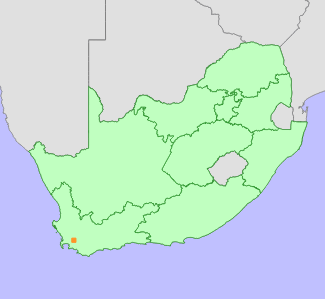|
Scientific Name | Erica sacciflora Salisb. |
Higher Classification | Dicotyledons |
Family | ERICACEAE |
Common Names | Dark-mouthed Heath (e), Swartbekheide (a), Swartbekkie (a), Swartbekkieheath (e) |
National Status |
Status and Criteria | Critically Endangered B1ab(i,ii,iii,iv,v) |
Assessment Date | 2012/05/15 |
Assessor(s) | R.C. Turner, E.G.H. Oliver, N.A. Helme & L. von Staden |
Justification | Erica sacciflora is a very localized (EOO 87 km²) species that has lost much of its habitat to forestry plantations in the past. Remaining habitat was also densely invaded by escaping pine seedlings from nearby plantations and other alien plants, that at one point, no surviving subpopulations could be found. However, after recent alien clearing, a subpopulation was rediscovered at one of the known localities. Although this is currently the only known subpopulation, it is suspected that more subpopulations may have re-emerged in response to alien clearing and fires. Ongoing alien clearing and management is required to prevent reinvasions and this species' population from declining again. |
Distribution |
Endemism | South African endemic |
Provincial distribution | Western Cape |
Range | Franschhoek Mountains. |
Habitat and Ecology |
Major system | Terrestrial |
Major habitats | Kogelberg Sandstone Fynbos, Hawequas Sandstone Fynbos, Boland Granite Fynbos |
Description | Low altitude slopes in sandstone fynbos. |
Threats |
| Threatened in the past by habitat loss to forestry plantations and competition from alien invasive plants. Alien plants have been cleared, particularly within the Berg River Valley, and Erica sacciflora plants appear to have re-emerged in response to the alien clearing. Ongoing alien clearing and management is however needed to prevent reinvasion and further population decline. |
Population |
Erica sacciflora was formerly quite common in the mountains around Franschhoek, however repeated searches at known localities failed to record any surviving subpopulations, and this species was thought to be extinct. However, in 2007 a subpopulation was rediscovered at one of the historical localities. It is suspected that extensive alien plant clearing followed by fires has led to the regeneration of plants from a dormant seed bank, and that there may also be other subpopulations within the surrounding area (N.A. Helme pers. comm.). More surveys are needed to establish whether or not other subpopulations exist, and until such time, this subpopulation is considered Critically Endangered.
|
Population trend | Decreasing |
Assessment History |
Taxon assessed |
Status and Criteria |
Citation/Red List version | | Erica sacciflora Salisb. | Critically Endangered (Possibly Extinct) | 2011.1 | | Erica sacciflora Salisb. | Critically Endangered (Possibly Extinct) | Raimondo et al. (2009) | | Erica sacciflora Salisb. | Endangered | Hilton-Taylor (1996) | |
Bibliography |
Goldblatt, P. and Manning, J.C. 2000. Cape Plants: A conspectus of the Cape Flora of South Africa. Strelitzia 9. National Botanical Institute, Cape Town.
Hilton-Taylor, C. 1996. Red data list of southern African plants. Strelitzia 4. South African National Botanical Institute, Pretoria.
Oliver, E.G.H. and Oliver, I.M. 2005. The genus Erica (Ericaceae) in southern Africa: taxonomic notes 2. Bothalia 35(2):121-148.
Raimondo, D., von Staden, L., Foden, W., Victor, J.E., Helme, N.A., Turner, R.C., Kamundi, D.A. and Manyama, P.A. 2009. Red List of South African Plants. Strelitzia 25. South African National Biodiversity Institute, Pretoria.
Schumann, D., Kirsten, G. and Oliver, E.G.H. 1992. Ericas of South Africa. Fernwood Press, Cape Town.
|
Citation |
| Turner, R.C., Oliver, E.G.H., Helme, N.A. & von Staden, L. 2012. Erica sacciflora Salisb. National Assessment: Red List of South African Plants version 2024.1. Accessed on 2025/10/24 |
 Comment on this assessment
Comment on this assessment

